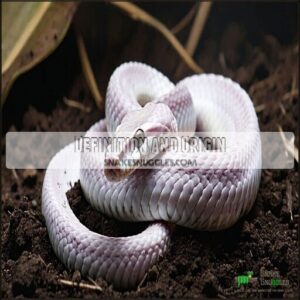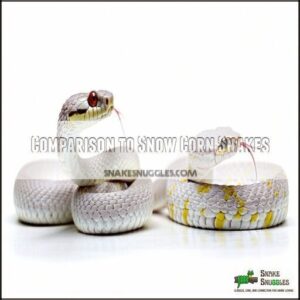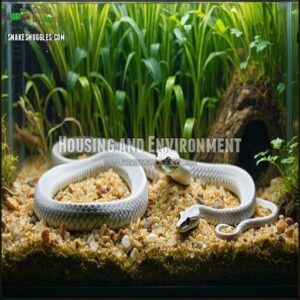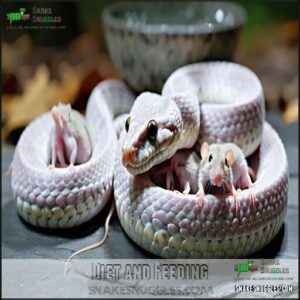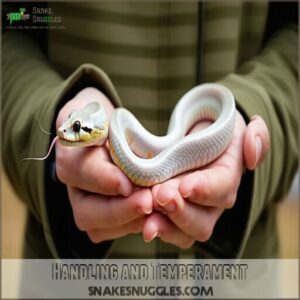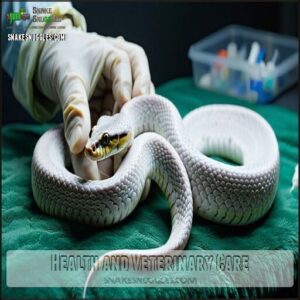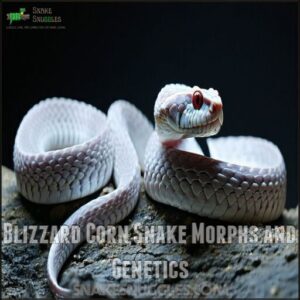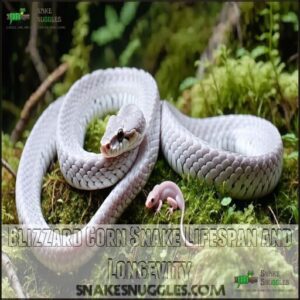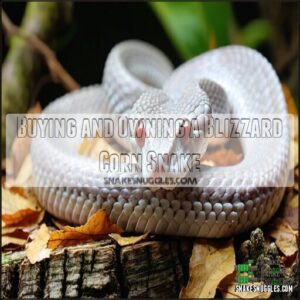This site is supported by our readers. We may earn a commission, at no cost to you, if you purchase through links.
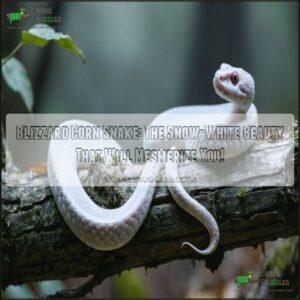 A blizzard corn snake is a striking morph with pure white scales and distinctive pink or red eyes.
A blizzard corn snake is a striking morph with pure white scales and distinctive pink or red eyes.
You’ll find these snakes are actually the result of specific genetic mutations that eliminate both melanin and yellow pigments.
They’re popular pets because they stay relatively small (3-5 feet), live 15-20 years with proper care, and have a gentle temperament that makes them perfect for beginners.
Your blizzard corn snake will need a secure 20-gallon enclosure, temperatures between 75-85°F, and a diet of appropriately-sized mice.
Their stark white appearance makes them truly stand out in the reptile world, though their specific care needs might surprise you, and they have a distinctive look with pure white scales.
Table Of Contents
- Key Takeaways
- What is a Blizzard Corn Snake?
- Blizzard Corn Snake Care and Handling
- Blizzard Corn Snake Morphs and Genetics
- Blizzard Corn Snake Lifespan and Longevity
- Buying and Owning a Blizzard Corn Snake
- Frequently Asked Questions (FAQs)
- What is a blizzard corn snake?
- Are Blizzard corn snakes suitable pets?
- How do you get a blizzard corn snake?
- Can a blizzard corn snake eat live prey?
- How long does A Lizzard corn snake last?
- Are Lizzard corn snakes White?
- How big do blizzard corn snakes get?
- What’s the difference between a blizzard and snow corn snake?
- Is a snow corn snake rare?
- How long do blizzard corn snakes live?
- Conclusion
Key Takeaways
- You’ll find blizzard corn snakes have a striking pure white appearance with ruby-red eyes, resulting from specific genetic combinations of amelanistic and charcoal traits.
- Your blizzard corn snake requires a 20-gallon enclosure with temperatures between 75-85°F, 40-50% humidity, and a diet of appropriately-sized rodents every 10-14 days.
- You’ll enjoy your snake’s docile temperament that makes it perfect for beginners, though regular gentle handling helps maintain socialization.
- Your pet can live 15-20 years with proper care, significantly longer than their wild counterparts that typically survive only 6-8 years.
What is a Blizzard Corn Snake?
You’ll find the Blizzard Corn Snake is a captive-bred reptile featuring striking white or cream-colored scales with distinctive ruby-red eyes, created by combining amelanistic and charcoal genes.
This docile snake grows to 2-6 feet in length, requires a temperature range of 75-85°F with 40-50% humidity.
The Blizzard Corn Snake makes an excellent pet for beginners due to its calm temperament and straightforward care needs.
Definition and Origin
The blizzard corn snake’s snow-white splendor represents a genetic masterpiece in the reptile world. This enchanting morph emerged through careful selective breeding in the early 2000s.
The creation of this distinctive snake involves:
- Combining two recessive genetic mutations: Amelanistic and Charcoal genes
- Requiring both parent snakes to carry these specific genes
- Producing offspring lacking natural camouflage patterns of wild corn snakes
- Creating a completely human-developed morph not found in nature
This morph definition showcases how corn snake morphs can display stunning amelanism origin through controlled breeding history of recessive genes, highlighting the significance of recessive genetic mutations and the result of selective breeding in creating unique species like the blizzard corn snake.
Physical Characteristics
After learning about their origins, you’ll be amazed by the stunning physical traits of these elegant reptiles.
The blizzard corn snake displays a pure white to cream-colored body with smooth, satin-like scales. Their most striking feature is their ruby-red eyes, which create a dramatic contrast against their snow-white skin.
These unique creatures result from combining charcoal and albino genetics, creating their distinctive ghostly appearance.
- Their bodies typically reach 2-6 feet long with a slender, muscular build
- The head features a pointed snout and rounded crown
- Their divided anal plate helps identify them as corn snake morphs
- White scales may show subtle variations with possible yellow hints on the belly
- Unlike other morphs, blizzard corn snakes completely lack melanin pigmentation
When light hits their scales, it creates a subtle, almost ghost-like effect that makes these white corn snakes truly enchanting specimens. Their scale coloration and body markings (or lack thereof) make them instantly recognizable among reptile enthusiasts.
Comparison to Snow Corn Snakes
While both display striking appearances, blizzard corn snake morphs differ substantially from snow corn snakes in several key aspects.
These differences stem primarily from their unique genetic makeup, which is a critical factor in their development.
| Feature | Blizzard Corn Snake | Snow Corn Snake |
|---|---|---|
| Genetic Composition | Charcoal + Amelanistic | Anerythristic + Amelanistic |
| Color Appearance | Pure white with minimal yellow | White with noticeable yellow hints |
| Pattern Visibility | Subtle, less defined patterns | More obvious saddles and markings |
Both morphs share ruby-red eyes due to their albino traits, but the charcoal genes in blizzard corn snakes create that coveted whiter appearance many collectors prefer.
Snow corn snakes typically develop more yellow pigmentation, especially around the jawline and neck area as they mature, which is a notable difference.
Your blizzard corn snake will generally maintain its frosty white coloration throughout its life, making it a unique and desirable pet.
Rarity and Availability
In the realm of snake morphs, blizzard corn snakes remain relatively uncommon compared to other varieties.
Current market pricing shows these distinctive snakes selling for about $150-200, reflecting their special breeding requirements and limited breeder availability.
The geographic distribution of breeders affects where you can find these snakes, with most available through specialized reptile stores, online platforms, and reptile expos.
Pricing factors depend on lineage quality, pattern clarity, and age.
Market demand for blizzard corn snakes continues to grow because of their:
- Stunning pure white scales that shimmer like fresh winter snow
- Mesmerizing ruby-red eyes that seem to glow with mysterious warmth
- Unique appearance that makes them stand out in any collection
Snake genetics play a key role in their rarity, as creating this snake morph requires specific combinations of charcoal and amelanistic traits.
These snakes are entirely white with red eyes, and may have a faint yellow line around their markings, similar to other amelanistic corn snakes.
Connect with reputable corn snake breeders for healthy specimens with proper documentation.
Blizzard Corn Snake Care and Handling
You’ll need a 20-gallon tank with proper temperature control (75-85°F) and regular handling to keep your blizzard corn snake healthy and content.
Your snake will thrive on a diet of pre-killed rodents every 10-14 days, making these docile reptiles an excellent choice for both new and experienced keepers, with regular handling being key to their well-being.
Housing and Environment
Setting up your Blizzard Corn Snake’s habitat requires attention to several key elements for peak health. Your snake enclosure should be at least 20 gallons with dimensions of 48 × 24 inches, giving your white beauty plenty of room to explore.
Maintain a proper temperature gradient with the cool side at 75°F and the warm side reaching 85°F using under-tank heating pads or ceramic heat emitters. Snake heating is vital for digestion and activity levels. To guarantee proper heating, consider using a reliable heat source.
For snake substrate, use 2-3 inches of aspen bedding or cypress mulch, which allows for burrowing behavior. Keep humidity levels between 40-50% with a water dish and adequate ventilation.
Don’t forget enrichment items—place multiple hiding spots on both warm and cool sides of the tank. These hideaways provide security and mental stimulation for your snake, making the enclosure feel more like home.
Diet and Feeding
Your blizzard corn snake’s diet plays a vital role in its health and longevity. These striking white reptiles have straightforward nutritional needs that are easy to meet with proper planning.
Here’s what you need to know about feeding your blizzard corn snake:
- Feed adult snakes appropriately-sized prekilled rodents every 10-14 days to maintain ideal weight
- Offer younger snakes smaller prey items twice weekly to support their rapid growth phase
- Select prey size that’s 1-1.5 times the diameter of your snake’s mid-body for proper digestion
- Always thaw frozen food completely at room temperature before offering
Fresh, clean water should be available at all times in a shallow dish. To guarantee safety, consider frozen thawed benefits over live prey. Watch for feeding refusals, which might indicate health problems. Most snake feeding issues resolve by adjusting prey size or feeding frequency. With consistent food types and proper supplementation, your blizzard corn snake can thrive for decades.
Handling and Temperament
When feeding your Blizzard Corn Snake is complete, you’ll want to handle them properly to appreciate their remarkable docile nature.
Your snake’s temperament ranks among the friendliest in the reptile world. They’re incredibly suitable for beginners due to their calm disposition and rarely show aggression.
For safe handling:
- Support their entire body when lifting
- Wait 48 hours after meals before handling
- Start with short 5-minute sessions
- Watch for relaxed muscles and curious tongue flicks
- Handle weekly to maintain their socialization
Regular, gentle interaction helps your snake remain comfortable with human contact, making them a stress-free pet companion.
Health and Veterinary Care
Many blizzard corn snakes require attentive veterinary care due to their unique albino genetics.
Your snake’s health depends on regular monitoring and proper environmental conditions.
| Health Concern | Prevention Method | Signs | Treatment |
|---|---|---|---|
| Respiratory Infections | Maintain 40-50% humidity | Wheezing, bubbles around nose | Reptile vet visit |
| Scale Rot | Keep substrate dry | Discolored belly scales | Betadine soak |
| Mite Prevention | Monthly enclosure cleaning | Black dots on scales | Specialized reptile spray |
| Brumation Issues | Proper temperature gradient | Lethargy outside winter | Adjust heating |
Schedule yearly checkups with a reptile-experienced veterinarian. It’s important to source reptile health products from trusted suppliers.
Keep detailed health records and provide fresh water daily to prevent dehydration. Genetic disorders may occur in captive-bred specimens.
Blizzard Corn Snake Morphs and Genetics
You’ll find that blizzard corn snakes come from breeding snakes with both amelanistic and charcoal genes, which must be homozygous in both parents to produce their striking white appearance with red eyes.
The white coloration results from the genetic combination that prevents melanin production while also eliminating red, yellow, and orange pigments, creating a snake that wouldn’t survive in the wild due to its lack of natural camouflage.
The resulting snake has a unique appearance, but the genetic combination that creates this striking white appearance is not beneficial for survival in the wild.
Understanding Corn Snake Morphs
Now that you’ve set up your blizzard corn snake’s habitat, let’s explore the fascinating world of corn snake morphs.
When you’re looking at corn snake morphs, you’re witnessing the results of selective breeding that has created over 800 stunning variations.
Understanding corn snake morphs involves three key elements:
- Color genetics – How different pigments combine to create unique scale colorations
- Pattern variations – The way markings appear along the snake’s body
- Scale morphology – Texture and appearance of scales that can vary between morphs
Each morph represents specific genetic traits that breeders have isolated and enhanced.
Your blizzard corn snake’s distinctive white appearance comes from a special combination of genes that block certain pigments.
Identifying morphs becomes easier when you understand basic genetics, helping you appreciate why your snake looks the way it does.
The science behind these color variations makes corn snakes one of the most diverse reptile species available to collectors.
Genetics of Blizzard Corn Snakes
The fascinating world of corn snake morphs leads us to examine what makes blizzard varieties truly special.
Your blizzard corn snake’s striking appearance comes from a specific genetic recipe: amelanism combined with anerythrism (charcoal).
These recessive genes must be inherited from both parents (homozygous traits) to create that distinctive snow-white body with ruby-red eyes.
Unlike other morph combinations, this genetic mutation eliminates both melanin and red pigments, resulting in the enchanting pure white appearance that snake enthusiasts prize.
Breeding and Producing Blizzard Corn Snakes
Building on our genetic discussion, breeding blizzard corn snakes requires careful planning and management. These stunning white serpents result from specific genetic combinations of Charcoal and Amelanistic traits.
To successfully breed blizzard corn snakes, you’ll need:
- Two parent snakes carrying the right genetic makeup (both must have Charcoal and Amelanistic genes)
- Proper incubation techniques maintaining 78-84°F temperatures
- Suitable substrate like vermiculite with 40-50% humidity for egg development
- Regular monitoring of the female’s health before and after egg-laying
- Patience during the 60-70 day incubation period
Clutch management is critical – expect 10-30 eggs per breeding cycle. Once hatched, your baby blizzard corn snakes will need special attention. They’ll start with a pinkish hue but gradually develop their signature white coloration. For ideal hatching success, consider investing in specialized incubation equipment.
Unlike other corn snake morphs, blizzard varieties showcase consistent white scales with striking red eyes. With proper snake breeding protocols, you’ll enjoy watching these unique reptile hatchlings thrive under your care.
Inheritance Patterns
After mastering the breeding process, you’ll need to understand how blizzard corn snakes inherit their striking appearance.
The snow-white coloration of your blizzard corn snake comes from a specific combination of recessive genes. Both parents must contribute amelanistic traits and charcoal genes for visual expression in their offspring.
This homozygous breeding guarantees the snake morph develops its characteristic white scales and ruby-red eyes. Unlike dominant genetic combinations, these recessive genes only show when paired together.
Snake breeding success depends on both parents carrying these specific genetic markers. With proper pairing, you’ll achieve the appealing blizzard pattern that makes this snake morph so desirable.
Blizzard Corn Snake Lifespan and Longevity
Your blizzard corn snake can live 15 to 20 years when you provide proper care including the right temperature, diet, and regular health checks.
You’ll need to maintain their habitat at 75-85°F with 40-50% humidity and feed them appropriately sized rodents every 10-14 days to guarantee maximum longevity.
Average Lifespan of Corn Snakes
Now that we’re familiar with the genetic makeup of Blizzard Corn Snakes, let’s look at their typical lifespans.
In captivity, Blizzard Corn Snakes live 15-20 years on average, compared to just 6-8 years for their wild counterparts. With ideal care, some snakes reach 23 years, making them long-term companions.
Your snake’s lifespan depends on several factors:
- Temperature regulation (75-85°F) directly impacts your snake’s metabolic health and immune function
- Proper nutrition with appropriately-sized prey supports organ development and prevents disease
- Regular health monitoring helps catch common ailments before they become serious
The reptile lifespan difference between captivity vs. wild environments demonstrates how environmental factors and diet substantially influence snake health and longevity.
Factors Affecting Longevity
Your Blizzard Corn Snake’s lifespan depends on several key factors that work together to determine longevity.
Proper care, diet, and environment ensure your Blizzard Corn Snake can thrive and live a healthy, long life of 15-20 years.
Genetic predisposition plays a fundamental role, with quality breeding lines typically living longer.
Environmental conditions, including proper temperature (75-85°F) and humidity (40-50%), create the foundation for healthy living.
Diet quality substantially impacts longevity—consistent feeding schedules with appropriately-sized rodents support ideal growth.
Regular veterinary access allows for early detection of potential health issues.
Environmental enrichment through proper habitat setup reduces stress, while gentle handling practices minimize anxiety.
When these factors are properly managed, your snake’s lifespan can extend to 15-20 years.
Snake genetics, coupled with attentive care, transform your reptilian companion into a long-term family member, influenced by genetic predisposition, environmental conditions, and diet quality, leading to a long-term and healthy life with proper care.
Health Issues and Diseases
While longevity factors set the foundation, keeping your Blizzard Corn Snake healthy requires knowing common ailments that might affect them.
Your snake’s health demands careful attention to these warning signs:
- Respiratory infections show up as wheezing or bubbling around the nostrils when temperatures drop too low
- Scale rot appears as discolored, raised scales when bedding stays wet too long
- Mites cause excessive soaking and visible black specks moving on your snake’s body
- Dehydration manifests through wrinkled skin and sunken eyes when humidity levels fall
- Mental distress reveals itself through constant hiding or glass surfing behaviors
Watch for abnormal shedding, weight loss, or unusual behavior that might signal problems. Snake diseases often develop slowly, making regular reptile health check-ups with a specialized vet essential.
Proper enclosure maintenance can prevent common corn snake ailments. Reptile health concerns can be managed effectively when caught early, giving your snow-white beauty the best chance at a long life.
Proper Care and Maintenance
Proper care can add years to your blizzard corn snake’s life.
Use a 20-gallon tank with correct temperature control (75-85°F) and humidity levels (40-50%). Maintain snake habitat with a consistent cleaning schedule and substrate choice of tree bark or aspen bedding.
bacterial growth
hydration
parasites
early
Buying and Owning a Blizzard Corn Snake
You’ll need to purchase your Blizzard Corn Snake from a reputable breeder who can provide health records and proper care information for this striking white reptile.
When selecting your snake, look for clear red eyes, a healthy weight, and active behavior to guarantee you bring home a thriving pet that can live 15-20 years with proper care.
Finding Reputable Breeders and Sellers
Finding a trustworthy source for your Blizzard Corn Snake requires careful research and attention to detail. When searching for snake breeders, look beyond the lowest price and focus on reputation and transparency.
A reputable breeder will:
- Provide health guarantees and detailed genetic lineage documentation
- Answer all your questions about the snake’s feeding history and temperament
- Show you proof of ethical breeding practices
- Offer ongoing support after purchase
Check online sales platforms and reptile forums for reviews about the seller. Specialized pet stores often have more knowledge than general pet shops. Reptile shows let you meet breeders face-to-face and examine snakes before buying.
Always verify morph authenticity—true Blizzard Corn Snakes have specific traits that distinguish them from other white morphs. Seller transparency about the snake’s age, feeding schedule, and health history is essential for making an informed decision.
Choosing The Right Blizzard Corn Snake
After locating reliable sources, it’s time to select your perfect blizzard corn snake. Look for specific health indicators and quality traits when making your choice.
| Selection Factor | What To Look For | What To Avoid |
|---|---|---|
| Physical Health | Clear red eyes, clean vent | Respiratory issues, stuck shed |
| Body Condition | Proper weight, smooth skin | Visible spine, lumps |
| Behavior | Alert, gentle handling | Aggressive striking, hiding |
| Feeding Record | Regular eating, proper prey size | Meal refusals, regurgitation |
| Genetic History | Pure blizzard traits | Unknown lineage, mixed patterns |
Ask the breeder about the snake’s eating habits and handling response. A good quality blizzard corn snake should appear bright white or cream with minimal markings and display a calm, curious temperament when handled.
Big Apple Pet Supply Policies and Guarantees
When purchasing your blizzard corn snake from Big Apple Pet Supply, understanding their buyer protection policies guarantees a worry-free experience.
Their guarantees include:
- A dedicated health guarantee covering genetic and congenital issues within 7 days of arrival
- Full shipping insurance that guarantees live arrival of your snake
- Accessible customer support for handling warranty claims efficiently
Their return policy allows exchanges within 48 hours of receiving your snake, though shipping costs aren’t refundable.
Payment options include all major credit cards and PayPal for your convenience.
Before purchasing, confirm that the breeder has a transparent health record, which is crucial for a peace of mind throughout the purchase process, offering safeguard to your investment in a new reptile companion.
Shipping and Pickup Information
After securing your health guarantee, it’s time to get your snow-white beauty safely home.
FedEx delivery brings your Blizzard Corn Snake with transit insurance included. Shipping costs cover specialized secure packaging designed specifically for reptile safety during transport.
We offer flexible pickup times at our facility if you prefer a hands-on approach. Before ordering, check delivery options and temperature restrictions—we can’t ship during extreme weather conditions.
Once your snake is en route, address changes aren’t possible, so double-check all details carefully. Most deliveries arrive within 1-3 business days, with tracking information provided so you can prepare for your new pet’s arrival.
Frequently Asked Questions (FAQs)
What is a blizzard corn snake?
White as snow, a blizzard corn snake is a captive-bred morph with pure white scales, ruby-red eyes, and a docile temperament.
You’ll find they’re perfect for beginners due to their easy care requirements.
Are Blizzard corn snakes suitable pets?
Yes, they’re ideal pets for beginners.
You’ll find these docile snakes easy to care for with their gentle temperament and minimal requirements.
They don’t need much handling but will tolerate it well.
How do you get a blizzard corn snake?
You’ll need to find a reputable breeder who specializes in corn snake morphs.
Blizzard corn snakes come from breeding snakes with both amelanistic and charcoal genes, creating their distinctive white appearance with red eyes.
Can a blizzard corn snake eat live prey?
While captive blizzard corn snakes can eat live prey, it’s not recommended.
You should feed them pre-killed or frozen/thawed rodents instead to prevent injury to your snake from defensive prey animals, as this is a safer approach.
How long does A Lizzard corn snake last?
Though you’d think they’d disappear like snow in summer, you’ll enjoy your scaly friend for quite a while.
Your corn snake can live 15-20 years in captivity with proper care, outlasting many childhood pets.
Are Lizzard corn snakes White?
Blizzard corn snakes aren’t just white – they’re stunning snow-colored reptiles with ruby-red eyes.
You’ll notice their scales have a pure white to cream coloration, sometimes showing subtle pink hues due to blood vessels beneath their translucent skin, making them stunning creatures.
How big do blizzard corn snakes get?
You’ll find your snake growing to impressive proportions—typically 2-6 feet in length as adults.
Your blizzard corn snake will maintain a slender, muscular build throughout its life, regardless of its striking white coloration.
What’s the difference between a blizzard and snow corn snake?
Both morphs have red eyes, but snow corn snakes display a pinkish-white color with visible patterns.
While blizzard corn snakes are pure white with minimal to no visible markings due to their charcoal and albino genes.
Is a snow corn snake rare?
Like diamonds that have lost their mystery, snow corn snakes aren’t rare anymore.
They’re a well-established morph combining amelanistic and anerythristic genetics.
You’ll commonly find them in the pet trade for less than $
How long do blizzard corn snakes live?
You can expect your pet to live 15-20 years in captivity with proper care, though some have reached 23-30 years. That’s substantially longer than their 6-8 year wild lifespan.
Conclusion
Who’d have thought a snake could be as white as snow?
Your blizzard corn snake isn’t just another pet—it’s a living masterpiece of genetics.
With proper care, these gentle reptiles will thrive for up to two decades, rewarding you with their unique beauty and calm demeanor.
Whether you’re a seasoned herper or first-time snake owner, the blizzard corn snake offers the perfect blend of striking appearance and manageable care that keeps enthusiasts fascinated year after year, making them a great choice for anyone interested in a living masterpiece.

